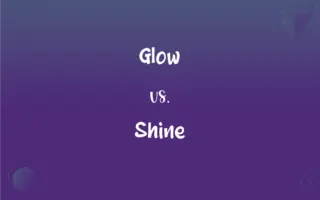Suspending Agent vs. Emulsifying Agent: What's the Difference?
Edited by Aimie Carlson || By Harlon Moss || Published on January 24, 2024
Suspending agents help keep particles dispersed in a liquid without dissolving, while emulsifying agents allow oil and water to mix by reducing surface tension.

Key Differences
Suspending agents are used to distribute solid particles uniformly in a liquid, preventing them from settling. Emulsifying agents, on the other hand, enable the mixing of oil and water by forming a stable emulsion.
The role of a suspending agent is to increase the viscosity of the medium, aiding in the suspension of particles. Emulsifying agents work by being amphiphilic, possessing both hydrophilic and lipophilic properties.
Suspending agents are crucial in formulations like suspensions in pharmaceuticals. In contrast, emulsifying agents are key in creating emulsions like lotions or salad dressings.
The effectiveness of suspending agents depends on their ability to form a thick, yet pourable solution. For emulsifying agents, effectiveness is measured by the stability and homogeneity of the emulsion formed.
Suspending agents do not alter the chemical nature of the suspended particles, merely aiding in their dispersion. Emulsifying agents, however, actively work at the interface of two immiscible liquids, such as oil and water, to stabilize the mixture.
ADVERTISEMENT
Comparison Chart
Primary Function
Keeps solid particles dispersed in a liquid
Allows mixing of oil and water
Action Mechanism
Increases viscosity to prevent settling
Reduces surface tension between liquids
Typical Use
Suspensions in pharmaceuticals
Lotions, creams, salad dressings
Property
Viscosity enhancing
Amphiphilic (hydrophilic and lipophilic)
Effect on Ingredients
Disperses without chemical alteration
Stabilizes the interface of immiscible liquids
ADVERTISEMENT
Suspending Agent and Emulsifying Agent Definitions
Suspending Agent
Ingredients that aid in the distribution of particles within a solution.
Gelatin is often used as a suspending agent in jellies to suspend fruit pieces.
Emulsifying Agent
Ingredients used in food and cosmetics to mix oil and water-based components.
Glycerol monostearate, an emulsifying agent, is used in ice cream to integrate fat and water.
Suspending Agent
Substances that keep solid particles dispersed in a liquid.
Xanthan gum acts as a suspending agent in salad dressings, keeping spices evenly distributed.
Emulsifying Agent
Agents that reduce surface tension to form stable emulsions.
Egg yolk, containing lecithin, acts as a natural emulsifying agent in homemade salad dressings.
Suspending Agent
Agents that increase the viscosity of a medium to prevent particle settling.
In cough syrups, cellulose derivatives serve as suspending agents to maintain the uniformity of the syrup.
Emulsifying Agent
Amphiphilic compounds that stabilize immiscible liquids.
Sorbitan oleate is an emulsifying agent in lotions, keeping oil and water phases combined.
Suspending Agent
Compounds used to stabilize suspensions in pharmaceuticals and cosmetics.
Bentonite clay is a natural suspending agent used in cosmetic face masks.
Emulsifying Agent
Compounds that facilitate the formation of a homogenous mixture from two liquids.
In pharmaceutical creams, stearic acid acts as an emulsifying agent to merge oil and aqueous phases.
Suspending Agent
Materials that prevent the sedimentation of particles in a liquid.
Polysorbate is used as a suspending agent in liquid soaps to keep ingredients mixed.
Emulsifying Agent
Substances that enable the mixture of oil and water.
Lecithin is used as an emulsifying agent in mayonnaise to blend oil and vinegar.
FAQs
What is a suspending agent?
A substance that maintains the dispersion of solid particles in a liquid.
What is an emulsifying agent?
A compound that helps mix oil and water by reducing surface tension.
What is the main function of an emulsifying agent?
To stabilize and blend oil and water into a uniform mixture.
Do suspending agents affect the taste of food?
Generally, they do not significantly alter the taste.
How do suspending agents work?
They increase the viscosity of the medium to prevent particle settling.
Can suspending agents change the nature of suspended particles?
No, they only aid in dispersion without altering the chemical nature.
Are emulsifying agents amphiphilic?
Yes, they have both hydrophilic and lipophilic properties.
Can emulsifying agents be allergenic?
Some individuals may have allergies to specific emulsifying agents.
Do emulsifying agents have a role in pharmaceuticals?
They are used in pharmaceuticals to create stable emulsions for creams and ointments.
In what products are suspending agents commonly found?
They are often found in pharmaceutical suspensions and certain food products.
What types of products use emulsifying agents?
Emulsifying agents are used in cosmetics, food products, and pharmaceuticals.
Can emulsifying agents be natural?
Yes, many natural substances like egg yolk act as emulsifying agents.
What is an example of a synthetic suspending agent?
Synthetic polymers like carbomer are commonly used as suspending agents.
Are emulsifying agents safe in food?
Yes, many food-grade emulsifying agents are considered safe for consumption.
How do suspending agents impact the shelf life of products?
They can enhance shelf life by maintaining product stability.
Can suspending agents be used in beverages?
Yes, they are used in beverages to maintain consistency and appearance.
Are there any environmental concerns with suspending agents?
Some synthetic suspending agents may have environmental impacts, hence the need for eco-friendly alternatives.
Is the choice of an emulsifying agent important in food production?
Yes, it affects the stability, texture, and shelf life of food products.
What is the role of suspending agents in cosmetics?
They help maintain the even distribution of ingredients in cosmetic products.
How do emulsifying agents affect skincare products?
They help blend oil and water-based ingredients, enhancing texture and absorption.
About Author
Written by
Harlon MossHarlon is a seasoned quality moderator and accomplished content writer for Difference Wiki. An alumnus of the prestigious University of California, he earned his degree in Computer Science. Leveraging his academic background, Harlon brings a meticulous and informed perspective to his work, ensuring content accuracy and excellence.
Edited by
Aimie CarlsonAimie Carlson, holding a master's degree in English literature, is a fervent English language enthusiast. She lends her writing talents to Difference Wiki, a prominent website that specializes in comparisons, offering readers insightful analyses that both captivate and inform.
































































